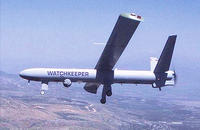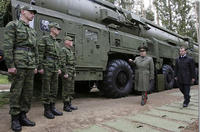-
U.S. worries Gaddafi may use poisonous gas as chaos deepens

Libya has in its possession 9.5 metric tons of mustard gas, and 650 metric tons of precursor chemicals used for developing chemical agents; in 2003, following the invasion of Iraq, Col. Gaddafi’s government sent to the United States the critical infrastructure for its nuclear-weapons programs, including uranium hexafluoride stockpiles, centrifuge machines, and parts for a nuclear fuel-conversion facility; Libya also destroyed its longer-range missiles and 3,300 aerial munitions used to disperse mustard gas and other chemical agents; the program to eradicate Libya’s chemical agents, as well as its chemical weapons production facility, was delayed by spats between Washington and Tripoli over funding and logistics; “When you have a guy who’s as irrational as Gaddafi with some serious weapons at his disposal, it’s always a concern,” said a U.S. official
-
-
Army mobilizing smart phones for combat

The U.S. Army is actively working to mobilize smart phones and apps to help soldiers on the battlefield; the Department of Defense currently operates an application store that features various apps that help monitor mental health and gather intelligence on allied and enemy movements; the Army has launched a program called Apps for Army, which encourages soldiers and civilians to help design apps; it also provides training for app development; the Army is hoping to expand app development and is discussing the idea to issue smart phones to every soldier; contractors like Raytheon are eager to enter this emerging market
-
-
Breakthrough in free-electron laser development
Breakthroughs in Free-Electron Laser (FEL) technology could mean a virtually impenetrable defense system for Navy ships; the laser weapon has the capability to detect and engage incoming cruise missiles at the speed of light without running out of ammunition
-
-
China's increasing military might causes concern in Asia, West
China’s recent test flight of its first stealth fighter comes as part of a larger military buildup that is concerning its Asian neighbors and the West; the Chinese test of their first fifth generation stealth fighter is years ahead of U.S. intelligence predictions; China is also moving ahead with the construction of its first aircraft carrier as well as other capabilities like a “carrier killing” ballistic missile; in response to China’s stealth fighter test, Taiwan test-fired nineteen missiles; nearly a third of the missiles failed; it is unclear what China’s intentions are though leaders claim these weapons are for self-defense
-
-
Amnesty complains about Brits training on Israeli UAVs

The British Army has ordered at least thirty Israeli-origin UAVs under the Watchkeeper program; the platform, called WK-450, has been based on the Hermes-450 UAV, produced by Israel’s Elbit Systems; in an interim measure, the British Army has ordered the Hermes-450 for its contingent in the NATO stabilization mission in Afghanistan; Amnesty International complains that British Army personnel have been training in Israel on these UAVs — UAVs which are deployed in the Gaza Strip where, according to Amnesty, the drones were involved “in serious human rights violations”
-
-
Marines use solar power in Afghanistan to help fuel the fight
Marines at Forward Operating Base Jackson in the Sangin valley of Helmand Province are using solar energy generators to stretch fuel supplies and save lives; with over 100 British troops killed there, Sangin valley is one of Afghanistan’s deadliest areas; since the implementation of portable solar energy generators, fuel consumption has decreased from twenty gallons to less than three gallons a day; delivering fuel is incredibly dangerous as fuel convoys are often ambushed or hit by IEDs
-
-
New generation of UAVs being tested
These are not your father’s UAVs; a new generation of UAVs represent a major technological advance over the Predator and Reaper drones that the Obama administration has deployed as a central element of the U.S. military campaign in Afghanistan; unlike most of the current fleet of more than 7,000 drones, the new remotely piloted planes will have jet engines and the ability to evade enemy radar; three members of the new generation of drones being flown in the coming weeks are speedier, stealthier, and higher-flying than their predecessors
-
-
The guns versus bows puzzle solved
In Western Europe, military bows became obsolete during the sixteenth century as firearms evolved; in China, however, guns and bows coexisted for almost a millennium; now one scientist thinks he knows why: it was easier to train musketeers than to train good archers, and the composite materials from which good bows were made did not fare well in humid conditions
-
-
Newly developed cloak hides underwater objects from sonar
University of Illinois researchers develop an acoustic cloak, a technology that renders underwater objects invisible to sonar and other ultrasound waves; an advantage of the acoustic cloak is its ability to cover a broad range of sound wavelengths; the cloak offers acoustic invisibility to ultrasound waves from 40 to 80 KHz, although with modification could theoretically be tuned to cover tens of megahertz
-
-
New Israeli technology speeds up warfare
Israel is among several nations harnessing digital and satellite technology to develop C4I systems — short for “command, control, communications, computers and intelligence” — that integrate battlefield information.; one Israeli officer says the goal is to have “all the elements of a force —- seeing the same tactical picture, and you can move information from one to the other completely seamlessly”
-
-
New laser weapon dazzles, confuses pirates
There were 430 pirate attacks last year, an increase of 5.6 percent on the previous year; in a bid to develop a suitable non-lethal weapon to help fend off this threat, BAE Systems studied pirate behavior; the conclusion was that an automatic weapon was needed, one that would not put any of the crew at risk, and one which would distract suspected pirates rather than harm them
-
-
U.S. to deploy see-all Gorgon Stare UAV
New U.S. UAV will be equipped with nine cameras which can transmit live video images of physical movements across an entire town; the new airborne surveillance system can send dozens of live images to a maximum of ten soldiers on the ground who would use hand-held devices similar in size to an iPad or Kindle
-
-
Biometric technologies save lives in the field
This is not your father’s military: Within minutes of knocking down the door of a suspected bomb maker in the Middle East, U.S. troops can fingerprint everyone they find inside, send scans across a satellite link, and find out if the subjects are suspected terrorists
-
-
New camera technology may give soldiers eyes in the back of their heads
DARPA is looking for ideas on how to develop a small and light device which will give the user zoom vision, various forms of night sight, and act as a heads-up display besides; perhaps best of all, the proposed kit would also offer “full sphere awareness” — that is, eyes in the back of your head
-
-
Senate to ratify New START pact today

The New START pact passed a key procedural hurdle on Tuesday when the Senate voted to bring the weapons pact between the United States and Russia to the floor of the Senate for a final vote, which is likely to be held today, Wednesday; the Senate voted 67-28 to pass a cloture motion, seemingly enough to assure final ratification; eleven Republicans joined with fifty-six Democrats to pass the cloture motion; it will take sixty-seven votes to ratify the New START pact; even if the U.S. arsenal is reduced by 30 percent, as stipulated in New START, the United States would still have 1,550 deployed strategic nuclear warheads; there are signs that these aging systems need refurbishing and modernization — and the $80 billion over ten years earmarked for this purpose is a good investment
-
More headlines
The long view
Factories First: Winning the Drone War Before It Starts
Wars are won by factories before they are won on the battlefield,Martin C. Feldmann writes, noting that the United States lacks the manufacturing depth for the coming drone age. Rectifying this situation “will take far more than procurement tweaks,” Feldmann writes. “It demands a national-level, wartime-scale industrial mobilization.”
